Grand Canyon Weather Guide: January 2023
Grand Canyon Weather in January
Grand Canyon Weather in the winter is a magical time to visit the national park. While there are some great advantages to visiting at this time of year, there are also some drawbacks to keep in mind.
If January is the month you’ve chosen to visit, we highly recommend it! With proper preparation, you can have a great time exploring the canyons and taking in the breathtaking winter scenery.
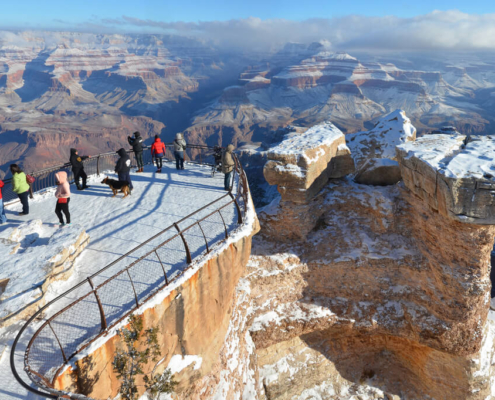
Benefits of Visiting the Grand Canyon in January
The main advantage of visiting the Grand Canyon in January is the lack of crowds. The South Rim is busiest in summer, and to a lesser extent in spring and fall. In comparison, winter is idyllic and quiet. Instead of crowded streets, long lines for service, and busy lookouts, the park is fairly quiet, calm, and probably snowy. Of the six million annual park visitors, less than 15% of them visit in December, January, and February, according to National Park Service records.
Fewer visitors also mean more accessible and cheaper accommodation. If you try to book within 6 months, you are more likely to not find accommodation in the summer, but in the winter you are more likely to find availability within weeks or months of your trip. Fewer tourists mean less than the best room rates, especially if you book in advance.
Another big advantage is the cool temperature in the canyon. The South Rim can be very chilly (but not always), but once you reach the bottom of the canyon the temperature evens out and is mostly perfect for hiking. This is a break from the 110+ degree heat of the canyon in summer, making the hike dangerous and less than enjoyable.
However, prepare for winter weather because you’ll experience the mild temperatures of the canyon’s bottom desert only after traveling through the mountains and forests of the South Rim. Hiking and backcountry camping permits are much easier to obtain in the winter. Last minute reservations are also commonly available at Phantom Ranch. In winter, wildlife viewing and photography opportunities abound.
The cold weather slows down many animals, but you can see mules and moose, condors, bighorn sheep, foxes, and bobcats. The canyon itself is majestic and worthy of a photo shoot at any time of year, but the recent snowfall gives it a completely unique look, with crimson and bloody orange rocks outlined only by white.
Drawbacks of Visiting in January
Unsurprisingly, January’s biggest drawbacks to the Grand Canyon are the South Rim temperatures and the potential for winter storms. The interior of the canyon is a desert environment, but the rim is a pine forested mountain ecosystem that receives several feet of snow each winter. This means that visitors should prepare for The Grand Canyon weather which is winter, with more equipment and clothing than if they were traveling in the summer or off-season. It may also eliminate the need to use winter gear, and the extra shopping and packing seem like a waste of time. It is not.
Hypothermia is really dangerous and slipping on ice or snow can seriously injure you. When a blizzard hits, it closes roads, makes hiking very difficult, and usually halts activity in the canyon. In addition to the potential for inclement weather, many of the South Rim hiking trails can be dangerous in winter, snow or not. Crampons and trekking poles are highly recommended for hiking in January. This can make this gear expensive and makes trails difficult to access for those who aren’t confident in their feet because they don’t want to hike, even with the increased traction this gear provides.
The North Rim is also closed from early November to mid-May, so the South Rim is the only option. This makes most of the park almost inaccessible and limits what you can see. The South Rim is beautiful and worth a visit, but many people feel they are missing out on not seeing the North Rim. Wildlife is still present in January, but many species are slowed down by the cold weather. No chance to see reptiles or amphibians and some of the larger animals are less noticeable due to their lack of activity. Another drawback is that not only is it colder than in summer, but the days are shorter. There is not enough time to enjoy hiking and sightseeing.
Things To Do in January
There is so much to do in the Canyon in January. In fact, most of the activities available at other times are your own choice. Sure, hiking the South Kaibab and Bright Angel trails is well worth it, but make sure you have crampons for the ice trails (Grandview, New Hans, and Tanner trails in winter).
Hiking is not particularly recommended, and experienced hikers can also backpack from the southern rim to the canyon’s enclosed northern rim, making it one of the most remote locations in the entire park. When there is snow on the ground, there are opportunities for snowshoeing and cross-country skiing, but these activities aren’t always as available as in places like Yosemite or Yellowstone. You can visit the park on a winter visit even if there is no snow on the ground.
Of course, there are many attractions in the park. When the road is clear, you can drive along most of the rim of the canyon and stop at various viewpoints. The most spectacular is on the west side, between the visitor center and Hermit’s Rest, but there are also great views from the east and south. Helicopter and plane tours, van and bus tours, and, if the roads are clear, bike tours are great activities (read Best Grand Canyon Tours for links to recommended companies). Attractions such as the Yavapai Geology Museum and Kolb Studios are worth a visit if the weather prevents you from going outside.
The 22nd visitor center cinema is a great way to learn more about the park in the warmth of the heated building. Another great way to wait for the weather to clear is to ride the Grand Canyon Railroad, which runs from Williams to the Canyon. You can also visit the Outlaws of the Old West.
West Rim is best visited with a visit to the Grand Canyon Skywalk (an all-glass bridge that spans nearly 4,000 feet above the canyon floor) or the Native American village of Eagle His Point. Guests can also enjoy an all-American dinner at the famous and historic El Tovar, a must-see in the Grand Canyon, and January is much easier to book than months in advance.
The Grand Canyon in January is perfect for wildlife and winter photography. Wildlife activity isn’t as active as in the summer, but patient visitors can catch a glimpse of some of the park’s iconic animals. One of the rarest birds in the world and one of the widest wingspans of any North American bird, the California Condor can still be seen flying over the Grand Canyon and has an excellent zoom lens It will be a great photo opportunity if you have one. sky high. Night sky photography is also popular, especially if you can bring part of the canyon wall to the forefront of your Milky Way image. Please bring layers and blankets.
Things To See in January
The Grand Canyon National Park is known for its sights, and there are almost as many things to see and do in January (read the section above, and you’ll see there’s a lot of it).
Below, we’ve compiled a list of must-see attractions in Grand Canyon National Park in January. This list is by no means exhaustive, so do your own research to find out what’s particularly interesting about the park.
Hermit’s Rest/Scenic Drive: This scenic drive is one of the park’s most popular and for good reason. The drive heads west along the South Rim, with numerous lookouts offering spectacular views of the canyon below. Winter is definitely the best time to drive this route as it is the only time you can drive this route.
A shuttle bus runs in the summer, but the road is closed to private vehicles, except for backpackers with permits, so you can only walk or bike. Being able to drive this route allows you to explore at your own pace and spend time at the viewpoints. At the end of the road is Hermit’s Rest, built in the early 1900s but designed to look like an old miner’s cabin.
Plateau point
Along the very famous and very popular Bright Angel Trail, this lookout offers one of the best views of the Colorado River in the park. This trail gets a lot of tourists in the summer, but in the winter there are fewer people and unfortunately more ice and snow. The Kaibab Trail is sunny and ice-poor, but the plateau point is spectacular, so for experienced hikers with crampons and trekking poles, a longer hike might be worth it.
Hopi Points
Hopi Point, along Hermit’s Rest Scenic Drive, is one of his best spots for sunrises and sunsets. With expansive panoramic views across the canyon and a glimpse of the Colorado River, this spectacular lookout is stunning any time of the year. However, you have the option of driving to this point instead of taking the shuttle. January is also the perfect time to catch the golden hour when the rocks bathe in the sun’s deep orange glow, as the sun sets early in the winter.
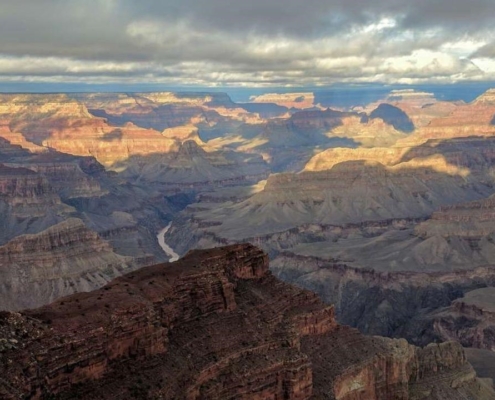
Desert View Watchtower
The watchtower is the first thing you see when you enter the park from the east, but few people stop to climb it, and sometimes you can’t climb it. Built in 1932 by architect Mary Colter, the tower’s design, which looks as if it soars out of a canyon, is based on the architectural designs of the ancestral Puebloans who lived on the Colorado Plateau. Inside is a replica of Native American kiva and cultural performances during the summer. Outside you have the first spectacular view of the canyon.
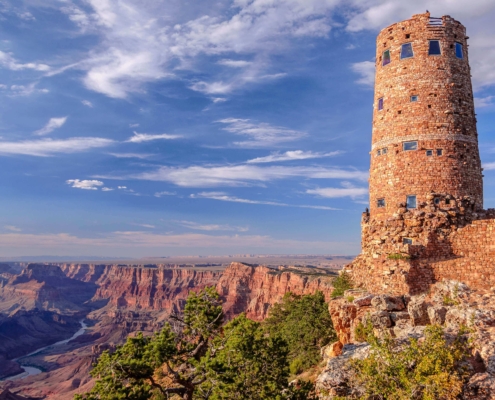
Hiking in January
As mentioned earlier, hiking in January can be very rewarding, and when returning from the canyon the temperatures are nearly perfect for physical activity. Unless you’re traveling with a tour operator or you’re an experienced hiker, we recommend sticking to the Bright Angel and South Kaibab trails.
The Bright Angel Trail is the most popular and famous but sees the most ice and snow of the easier trails in the winter (it’s popular in the summer) because the trail has a lot of shade. Expect to encounter ice for at least the first three miles of this trail.
The South Kaibab Trail, on the other hand, receives more sun and heat during the day. The first quarter of the trail, called the Chimney, faces north and remains ice and snow all winter, although there is intermittent ice below this section.
Whichever trail you choose, you should bring crampons or micro spikes for extra traction along the trail. Similar to chains that slide into your car’s tires, microspikes are for boots and are made of chains, rubber, and tiny spikes that dig into ice or hardened snow to increase traction. I just need a little ice to appreciate having these devices.
Most of the Grand Canyon’s trails are steep, so you’re more likely to slip and slide if you try to climb them without extra leg support. This gear may seem expensive, especially for a short trip to the Grand Canyon, but it’s essential. Tour companies include this when you book a tour. This can reduce costs.
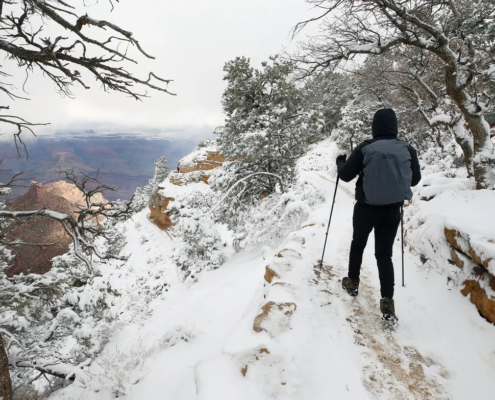
Early mornings can be very chilly at the southern end where the hiking trail begins. Therefore, bring warm layers, especially insulating layers, a windproof outer jacket, gloves, and a warm hat. Because the days are short in winter, starting the hike at 8 or 9 am and limiting the hike to 6 to 8 hours. is best. When the sun goes down, the temperature plummets, and when the sun sets and the ice that melted during the day begins to refreeze, you won’t want to go outside.
Hypothermia is a real danger in the Grand Canyon during winter. It is important to recognize the signs of this condition and understand what to do if you or one of her in your group experiences this condition. You don’t have to be below freezing to be hypothermia. Instead, the body cannot regulate body temperature after exposure to cold or damp conditions.
Hypothermia causes confusion and neglect, so it’s hard to know if you’re suffering. So hike in groups and make sure everyone knows how to prevent this condition. This will prevent the cold that causes hypothermia. Look for “murmuring” symptoms – complaining, stumbling, murmuring, fumbling.
Stay hydrated while hiking, even if it’s cold. It may be best to ship in an insulated container to prevent freezing. Recently, there has been an increase in deaths from “water poisoning” in the canyons. This is a life-threatening condition in which the sodium in the body is out of balance and the cells swell with water. Foods that help maintain sodium balance in the bloodstream.
Wildlife in January
Wildlife in the Grand Canyon is less active during the winter months compared to the summer and off-season. Because reptiles and amphibians hibernate due to the cold weather in the grand canyon, you won’t see many of the park’s major desert animals, including rattlesnakes, frilled lizards, and Gilla monsters.
However, in winter you can see many animals roaming outside. Both mule deer and elk are still active and can be seen foraging on the fringes among the evergreen ponderosa pines. You may be able to see peregrine falcons and bald eagles soaring over the canyon. The park’s squirrels, rock squirrels, and Albert’s squirrels are on loan for most of the winter but occasionally come out for food.
Some species grow tufts of fur on their ears to keep out the cold. Perhaps the most famous wildlife in the Grand Canyon is the endangered California condor. The largest bird native to America, the California condor has a wingspan of up to 9.5 feet and weighs up to 23 pounds. These birds are scavengers and are often mistaken for turkeys in flight. You can tell the difference between these birds by how they fly. While turkey vultures appear to be wobbly in flight, condors have a much smoother wing pattern.
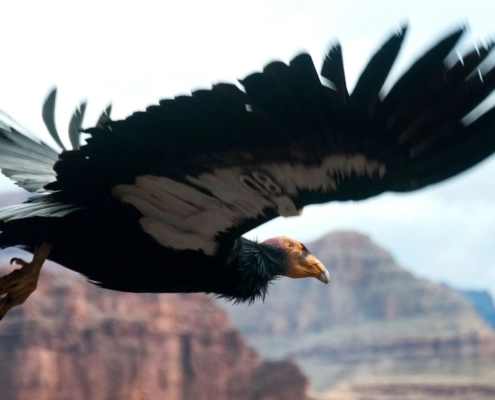
Appearing to be on the same land as the sea albatross, the condor can travel many miles a day and rarely sleeps two nights in a row in the same place unless there is a nest. A condor breeding pair lays only one egg every two years, making the recovery of the condor from near extinction through captive breeding and subsequent release into the wild a remarkable conservation success story. It’s a story.
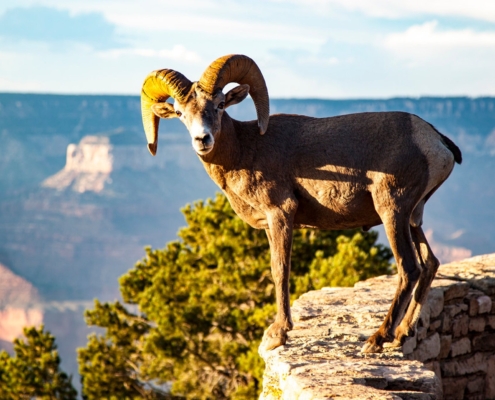
Another distinctive wildlife native to Arizona is the javelina, also known as the collared peccary. Although many people call them by various common names and they resemble pigs, javelinas actually belong to a different family and maintain a strict diet that sometimes includes cacti. Grand Canyon National Park hosts hundreds of species, but visitors rarely spot many of them.
The park is inhabited by bighorn sheep, but they are often invisible as they have blended into the rocks. Mountain lions, coyotes, bobcats, and gray foxes also live in this habitat, but all but coyotes are generally shy and avoid humans. Snow leaves more footprints than dirt, which is beneficial for those looking for wildlife. Many of these species are less active due to the cold weather in the grand canyon, but patient visitors can still catch a glimpse of them and it’s well worth the wait.
Weather in January
The Grand Canyon is a large park and due to the nature of the canyon landscape, the weather can vary greatly between the canyon rim and the canyon itself. In January, the South Rim has an average high temperature of 44 degrees Fahrenheit and an average low temperature of 18 degrees Fahrenheit (high 6.6 degrees Celsius, low -7.7 degrees Celsius). However, these temperatures are much warmer inside the canyon (about 10-20 degrees, but even warmer in the sun).
The average rain/snow days in January are 5 days. Phantom Ranch, at the base of the canyon, has an average high temperature of 58 days in January. Visitors should keep in mind that these temperatures are only average and the park can experience much warmer and much colder temperatures than these. Rain and snow, and moderate and sub-zero temperatures can make packing for a trip difficult, as you’ll need to bring both fall and winter gear. Rain that falls during the warmer hours of the day is more likely to freeze overnight, creating dangerous conditions for roads and trails.
Snowfall is heavy and roads may be temporarily closed, so it’s a good idea to bring a deck of cards and a good book in case the Grand Canyon weather keeps you out for a day or two I guess.
Mornings tend to be cool and temperatures drop sharply after sunset, so be careful to avoid exposure to the elements on your hikes and after-sunset activities. If the activity lasts longer than a few hours, start in the morning, but watch out for areas of ice with a layer of surface water that has melted in the morning light. This makes the ice more slippery and dangerous. Slipping on ice while hiking cliffs can quickly become a disaster, so crampons or micro spikes are a must at this time of year. Some hiking trails in the area require cross-country skis or snowshoes.
Hypothermia is a very serious threat in the Grand Canyon. Take off your winter clothes before you start shivering, put on your rain/snow gear before getting wet, and seek shelter or turn on protection when the Grand Canyon weather shifts. Always prepare for the worst Grand Canyon weather conditions. Wear layers that you can put on and take off so you can regulate your body temperature if the temperature changes. It’s usually too hot with just a ski jacket, but too cold when you take it off.
Always check the Grand Canyon weather forecast and current conditions before embarking on your hike, and check with rangers at the visitor center for specific information about the various trails and roads.
Final Takeaways
Visiting the Grand Canyon in January offers a unique and quieter experience with fewer crowds and more accessible and cheaper accommodations. The cool temperatures in the canyon make for a comfortable and safe hiking experience, and the park’s wintery atmosphere provides ample opportunities for wildlife viewing and photography. However, you should prepare for the colder temperatures and potential winter storms at the South Rim and bring appropriate gear, like crampons and trekking poles, for hiking.
If you’re considering a visit to the Grand Canyon in January and want to make the most of your trip, I highly recommend considering the services of a travel agency such as Sweetours. We can help with planning and accommodation, and even provide guided tours to ensure you have a safe and enjoyable experience while getting to see all that the park has to offer in the winter.

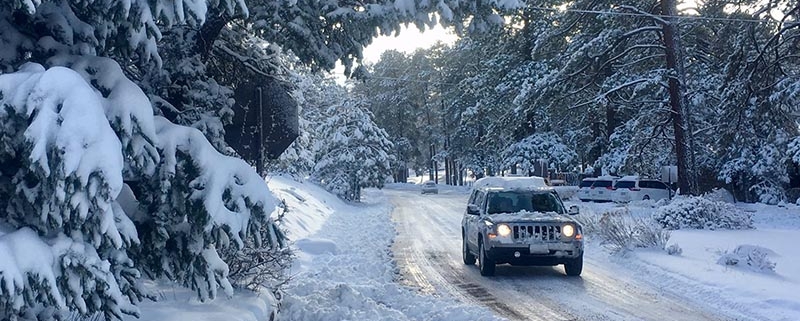

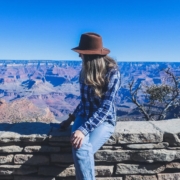
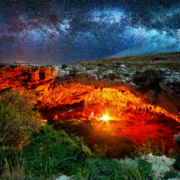
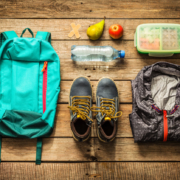
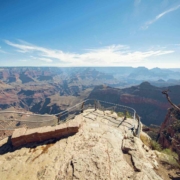
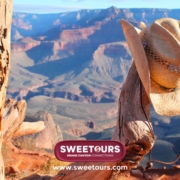


Leave a Reply
Want to join the discussion?Feel free to contribute!